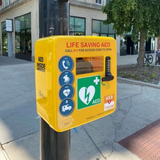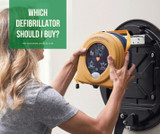Do AED cabinets require power?
Automatic external defibrillator (AED) cabinets are used to store defibrillators when they are not being used. Usually mounted on a wall and painted in a vibrant colour, they keep defibrillators safe from damage, vandalism and theft. Labelled with the medical symbol for AED so that they can also be easily identified, you may find an AED cabinet in your place of work, supermarket, local town or village or your child’s school.
Defibrillator cabinets come in a range of sizes, colours and shapes depending on where they will be located and the size of the defibrillator that will be stored in it. Many AED cabinets are made from metal to protect the defibrillator inside however, there are also indoor cabinets that are manufactured with a plastic outer face. As defibrillator cabinets that are outside are subject to the weather, the location of the defibrillator often depends on whether the cabinet requires power or not.
Although AEDs themselves do not require power, some but not all AED cabinets do. If your AED is located indoors, in a generally safe location, the chances are it will be fine being stored in a simple cabinet that will protect it from wear and tear, whilst making it easy to locate. If however, your AED cabinet is located outdoors or in an environment where you are concerned it could be vandalised, stolen or damaged due to severe weather you may want to opt for a defibrillator cabinet that requires power.
AED cabinets that have power can provide different features such as an alarm, lighting, heating or, all three. With clever alarm and heating systems, these AED cabinets ensure the contents inside remain safe and can be used whenever they are needed.
Heating elements can work in temperatures as low as -45 degrees to ensure the defibrillator inside doesn’t drop to low in temperature where it may struggle to work. Alarms prevent theft and vandalism and internal lights also help with identification when it is dark outside. These features all aid in either preventing the defibrillator from damage or, to ensure it can be used when there is an emergency.
There are a number of AED cabinets available that either do or do not require power. When thinking about where your defibrillator will be located, it’s then a good idea to decide which cabinet you feel will be best. For example, if a defibrillator is located in your home, local supermarket or office, it is more than likely that you don’t need a powered AED cabinet. If a defibrillator is going to be located outside, will be subject to severe weather or in a compromised setting, it is probably best to consider a cabinet that requires power.
To view our full range of AED cabinets click here:
https://risk-assessment-products.co.uk/aed-cabinets-cases/
Recent Posts
-
Empowering Communities: The Lifesaving Impact of CPR on Restart a Heart Day
Every year, on and around October 16th, an important event takes place - Restart a Heart Day. This a …16th Oct 2023 -
Which home defibrillator?
80% of all out of hospital cardiac arrests occur at home. Defibrillators are often available in loca …4th Dec 2022 -
Which defibrillator should I buy?
There are many defibrillators available on the market and it can become overwhelming knowing which o …4th Nov 2022




